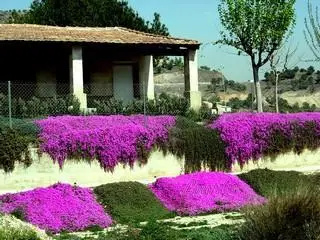Those plants that are capable of completely covering the soil in a leafy way are called carpets. Therefore, it is not a category of plants but of species from which certain peculiarities are exploited. We will tell you which are the types of upholstery plants that are most used to cover floors and walls, as well as some basic care to take into account to take care of the upholstered area.
Types of upholstery plants to cover floors and walls.
Depending on the growth system of the plant in question, we can distinguish different types of cover plants :
- Those that widen in the shape of a crown around a central root (yarrow or thyme).
- Those that spread through stolons (such as Hypericum calycinum ).
- Shrubs that grow wider than tall, with long, drooping branches (such as creeping rosemary).
- Climbers that take advantage of the horizontal position for their development (such as ivy, clematis and honeysuckle).
These plants are an interesting alternative to pavement or grass, especially in those situations where it is better to discard the others. Dark areas under leafy trees, steep places or difficult to access with the lawnmower, corners punished by the sun or the wind are ideal for certain upholstery and will allow us to improve aesthetics at a low cost.
If we choose correctly they can serve as a corrective element for aesthetic deficiencies of other plants. In the case of shrubs that tend to lose their leaves in the lower part, it will allow us to hide this characteristic and in those areas with tall and dark vegetation we can provide light with species of light foliage.
For each type of area there is a more appropriate species but, in general, there are basic rules to obtain a thick and homogeneous coating. Here are some guidelines for growing ground cover plants :
- Work the soil and clean it of herbs before planting.
- Leave a space between the plants taking into account their future development, since some excess density will force us to extract some after a few years and a defect in the plants will reveal what is intended to be covered.
- Systematically remove the weeds until the plants have covered the entire area, using a light layer of pine bark as an aid. Once fully developed, they will prevent the passage of light and the maintenance task will be reduced to irrigation and the containment of its growth depending on what we want.

